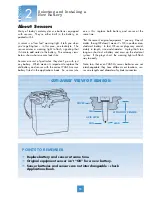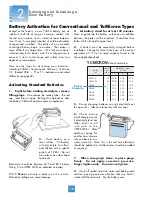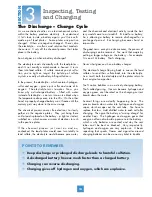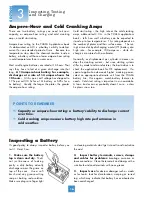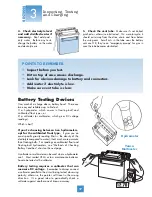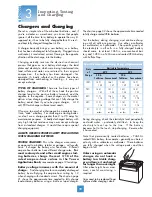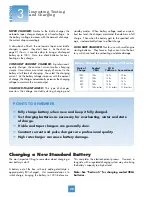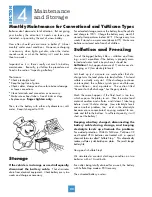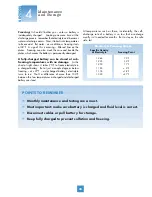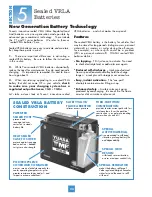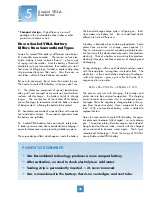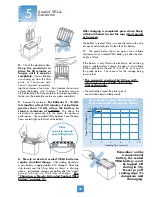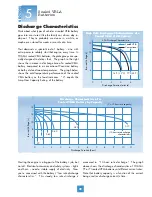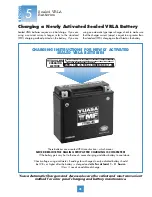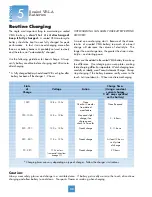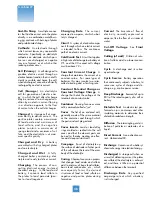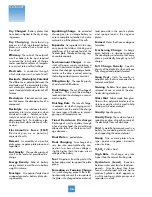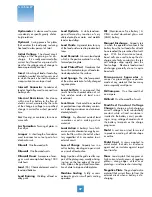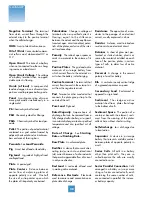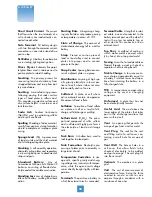
POINTS TO REMEMBER
❐
Gas Recombinant technology produces a more compact battery.
❐
After activation, no need to check electrolyte or add water.
❐
Sealing strip is permanently inserted — it’s never removed.
❐
Gas is recombined in the battery; there’s no vented gas and vent tube.
25
The basic discharge-charge cycle is still going on… that’s
what makes any battery tick. But to understand what’s
different, let’s do a little review:
A battery is basically a box containing lead plates. Some
plates have a positive (+) charge, some negative (-).
They’re immersed in a current-conducting electrolyte solu-
tion that sets off the electrochemical process that produces
electricity. Think of a battery as a machine that produces
electricity through a continuous process of charging and
discharging.
During discharge, sulfuric acid electrolyte solution reacts
with the lead plates, turning them into lead sulfate. The
electrolyte – sulfuric acid solution made up of hydrogen,
sulfur and oxygen – gives up its sulfur and some of its
oxygen and turns to water.
PbO
2
+ Pb + 2 H
2
SO
4
→
2 PbSO
4
+ 2 H
2
O
The process reverses with charging. Electrolytes and
plates return to their original composition. The charging
current breaks down water into its component gases:
hydrogen (from the negatively charged plate) and oxy-
gen (from the positive plate). Gases escape out the vent
tube. With a conventional battery, water is added to
replace that loss.
Here’s the real secret of a sealed VRLA battery: the nega-
tive plate never becomes fully charged… so, no hydrogen
gas. The positive plate still makes oxygen, but instead of
being forced out the vent tube, it reacts with the charged
active material to become water again. That’s “gas
recombinant technology.” That’s the magic of YUASA’s
non-spillable, sealed VRLA battery.
●
Compact design
– High efficiency in a small
package, with no vulnerable exhaust tubes or other
protrusions to break or kink.
How a Sealed VRLA Battery
Differs from Conventional Types
Some of a sealed VRLA battery’s differences are obvious.
It’s noticeably more compact. The reason: no free elec-
trolyte, making it more “volume efficient” – a fancy way
of saying it can be smaller. Since the battery is filled with
electrolyte just once (at activation), then sealed, you won’t
find a row of filling plugs. Instead, a single sealing plug
strip permanently covers filler ports. Also, there are no
vent tubes – after all, these batteries are sealed!
But as with any magic, there’s more than meets the eye.
The heart of a sealed VRLA battery is what you don’t see.
1.
The plates are comprised of special lead-calcium
alloy grids and charged active material. Lead-calcium
reduces self-discharge – the battery holds its charge
longer. The construction of the sealed VRLA battery
causes freed gas to recombine inside the battery instead
of being vented… allowing the battery to be sealed.
2.
Separators are made of a special fiber with superior
heat and acid resistance. These special separators make
the battery non-spillable.
3.
Sealed VRLA batteries have an internal safety valve.
If battery pressure soars due to accidental overcharging, it
opens to release excess gas, preventing a battery rupture.
The unique design affects what happens inside the battery.
5
SECTION
Sealed VRLA
Batteries
Summary of Contents for SmartShot Automatic 12V 1.5 Amp 5 Stage
Page 1: ......

